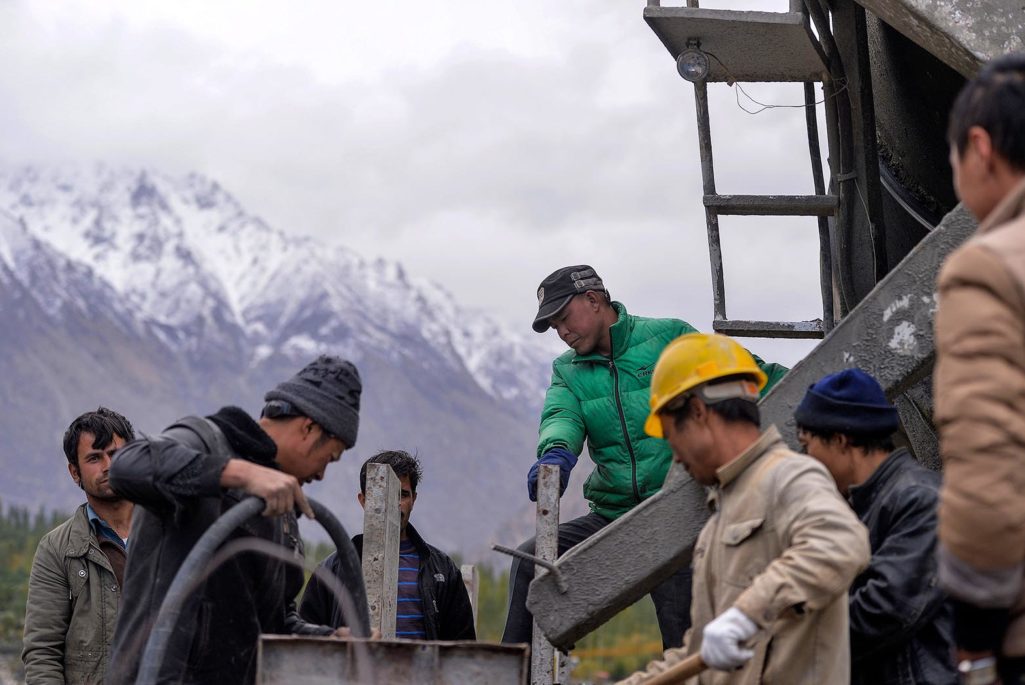China’s Steady March to Global Leadership

Chinese laborers work on the Karakoram highway, in Gulmit village of Hunza valley in northern Pakistan. A glossy highway and hundreds of lorries are transporting Chinese workers by the thousands as the new Silk Road is under construction in northern Pakistan.
Photo: Aamir Qureshi/AFP/Getty Images
In the first quarter of 2017, China’s economy grew at 6.9 percent, beating analysts’ forecasts and surpassing its annual target. Other data is indicative of a solid economy and a continuing growth trend.
For instance, the General Administration of Customs reported that imports of iron ore were 91.52 million tons in May, up from 86.75 million tons a year ago. Iron ore imports are a leading indicator of economic well-being and reflect China’s new surge in domestic and international infrastructure programs, particularly the Belt and Road Initiative.
The improved gross domestic product (GDP) figures prompted the National Bureau of Statistics to suggest that China’s economy had become “more stable, coordinated and sustainable“; yet it also cautioned that external influences and global uncertainty were still important factors that could negatively impact China’s development.
One aspect of concern is the growing volume of overseas investments by a few large Chinese conglomerates. The recently concluded National Financial Work Conference, held once every five years, stressed that China’s financial sector needs to better serve the real economy, and overseas acquisitions aren’t necessarily a way to do that. In parallel, the country’s banking regulator is looking more carefully at leading Chinese investment companies to study the loans they have assumed overseas.
Such activity perhaps follows global concerns that have seen both European and U.S. regulators levy massive fines on bankers. It would thus be prudent to show that Chinese regulators fully understand their position while they open up the internal markets to new trading by a few specialist institutions such as UBS, BlackRock and Fidelity.
While there is a massive amount of unmanaged capital available for management and investing globally, only recently has the Chinese domestic market been opened to allow managers to directly target high-net-worth investors to offer them onshore fixed income, equity and multi-asset private fund investment options.
China’s Surge
China’s surge is evidenced in its rapid progress across different dimensions, both domestically and internationally. First, this includes the development of its domestic financial markets (partially represented by these new fund management firms being allowed to set up shop in the country). Second, China’s internal growth management—striking a balance between economic growth and sustainability—comes hand in hand with its commitment to the 2015 Paris agreement on climate change, an agreement that China is arguably leading following the U.S. pullout. Finally, its surge is demonstrated through its commitment and success in achieving the 2015 UN Sustainable Development Goals (SDGs) with respect to lifting as many people out of poverty as possible.
There are signs that the U.S. is limiting its role in the Asia-Pacific region—while China is expanding its reach.
Its drive is not being accentuated with its focus on the Belt and Road Initiative and its implications.
The Belt and Road Initiative is becoming more visible across Central Asia and beyond. For instance, Kazakhstan and China jointly built the China-Kazakhstan Horgos Frontier International Cooperation Center, which straddles their border. A new priority for the initiative is the central corridor that will link Urumqi to Bishkek (in Kyrgyzstan) via Khorgos, and from there to Tashkent (Uzbekistan), Ashgabat (Turkmenistan) and finally to Tehran (Iran), based on a top-class fast rail system running through states that presently lack the finance and technical skills to build such interconnections.
Much like the old days, the new corridor is expected to spark innovation along its routes, tapping natural resources and tourism, and invigorating large populations in these countries.
Gradual Steps Toward Global Leadership
China has promoted “Socialism with Chinese characteristics” starting in the 1980s, and a key party plenum in November 2013 pledged a “decisive” role for markets in the economy. This was not only a slogan, but it was also supported by policy directives and guidance, leading to the development of engineering, science and commercial strengths that are visible today.
In contrast, U.S. President Donald Trump trumpeted “Make America Great Again” during his election campaign run, spurring populist voters to elect him. Presently, U.S. business leaders acknowledge the International Monetary Fund’s view that U.S. productivity is low, even if employment is high.
The differences between China and the U.S. are obvious. While there are clear signs that the U.S. could be inadvertently limiting its role in the Asia-Pacific region (at least from a global trade perspective), as illustrated by its withdrawal from the Trans-Pacific Partnership, China is redoubling its efforts to see the Regional Comprehensive Economic Partnership come to fruition.
Additionally, through its initiative, the Asian Infrastructure Investment Bank has become a prominent multilateral development bank in little more than a year. Having started operations in early 2016, the bank already has 80 approved members from around the world, further strengthening China’s global role.
China is also independently developing widespread infrastructure projects across the region. The three rail and road corridors (the northern route through Mongolia into Russia and then to Europe; central, as mentioned above; and the southern route from Kashgar through Islamabad to Karachi and Gwadar Port) offer huge opportunities for millions of people. Trade and other exchanges will develop.
It could also nurture new intellectual growth and technical innovation hubs to build the future of the Asian resurgence led by China. The long links into Europe, not only from China, will support trade and other exchanges of benefit contributing to the world’s development.






